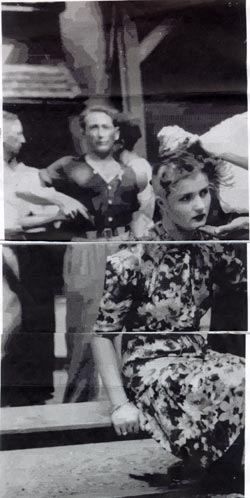| |
Across France
With Patton
Gen. Patton had begun his sweep across the heart
of France to the South of Paris, using three spearheads,
each containing an armored division and a mobile
infantry division. The XII Corps, which included
the 35th Division and the 4th Armored, were the
right or Corps on the South, with the mission
of protecting the right exposed flank of the Third
Army. Each infantry regiment became a task force
or combat team including an artillery battalion,
companies of the 747th Tank Battalion and 654th
Tank Destroyers, engineers and supporting units.
448th A.A. Battalion provided aerial defense and
frequently lowered its guns for ground support.
Thus, proceeded the greatest blitzkrieg demonstration
of the war, the dash across France.
Along the road to Le Mans, the French people,
delirious from their delivery from four years
of German occupation, lined the roads to greet
and cheer on the Americans, waving flags, giving
flowers and food, cider and wines, everywhere
the signs of “V” for Victory.
The first objective for the division lay eighty
miles to the East – the magnificent and
historical city of Orleans, former home of Joan
de Arc, and 65 miles South of Paris. It was located
on the North bank of the Loire River and a major
supply center for the German Army and the site
of a great airfield. We were to reduce all opposition
by passed or too much for the 4th Armored Division
to handle. Ahead would fly the Air Force. Their
success was marked by the great numbers of overturned
and burned out tanks, guns, half tracks, and trucks
which were strewn along the countryside. At 11
a.m. on August 15th, the division moved out, led
by Gen. Sebree’s tank forces, later joined
by Combat Command A of the 4th Armored Division.
Thirty hours later it arrived at Orleans to seize
the airport and the crowded warehouses against
light, surprised opposition. Combat team 134 followed
to take on independent missions along the way
as assigned.
Combat team 320 was routed 40 miles toward Paris
to take Chateaudun where strong German artillery,
mortar and rocket troops were located. At 8:30
a.m. on August 16th, Col. Byrne, Combat Team Commander,
launched a “textbook” attack on the
Germans who had been assigned to defend a large
airport outside of Chateaudun. 320th Mortar Platoons
showed their special talents with accurate and
effective fire. Five tiger tanks were knocked
out and by noon on the 17th, all resistance had
ended in Chateaudun, and also in nearby Cloyes
which had at first been temporarily bypassed.
The area was then secured.
 South
of the Loire River, at Orleans, German snipers and artillery
from across the river, intermittently dropped in rounds on
the city but were unable to stop the occupation or the parade
and liberation celebration of the local citizenry in which
division personnel participated at the insistence of the French.
The Germans had blown the bridges across the Loire River and
had destroyed the city’s water system. No problem said
the 60th Engineers who hooked up their equipment and supplied
the city with 80,000 gallons a day. Here we met the Maquis
and the Free French underground who provided intelligence
and were ready to take over local defense. Here also we observed
how the French took retribution on the collaborators, mostly
women, who had consorted with the Germans during the occupation.
Their hair was shorn and in some communities the ladies were
disrobed and paraded in nature’s garb. South
of the Loire River, at Orleans, German snipers and artillery
from across the river, intermittently dropped in rounds on
the city but were unable to stop the occupation or the parade
and liberation celebration of the local citizenry in which
division personnel participated at the insistence of the French.
The Germans had blown the bridges across the Loire River and
had destroyed the city’s water system. No problem said
the 60th Engineers who hooked up their equipment and supplied
the city with 80,000 gallons a day. Here we met the Maquis
and the Free French underground who provided intelligence
and were ready to take over local defense. Here also we observed
how the French took retribution on the collaborators, mostly
women, who had consorted with the Germans during the occupation.
Their hair was shorn and in some communities the ladies were
disrobed and paraded in nature’s garb.
On August 21st, 1944, Maj. Gen. M.S. Eddy, New
XII Corps Commander, forwarded Gen. Patton’s
letter of commendation to the XII Corps for its
“magnificent performance” in the capture
of Orleans and Chateaudun.
Moving closer to Paris, the division combat teams
had field days on key French cities and confusing
and overrunning isolated pockets of resistance.
To the 137th infantry fell the city of Sens about
60 miles southeast of Paris and a major supply
center. Next came Montargis, taken August 23rd
by the 134th and 320th combat teams, working in
concert. 320th claimed Courtenay on the 24th and
C.T. 134 took Joigny on the 25th. Prisoners poured
into the prisoner of war cages by the thousands
as light resistance kept the 35th casualties at
a low tally. Next fell Troyes on the Seine River,
compliments of Task Force S, but this time using
the 320th Infantry. By the 1st of September, Task
Force S was at Brienne Le Chateaux, just 65 miles
West of Nancy and the Mosell River which would
soon warm up our war again. We were nearing the
battlefields where the 35th Division had fought
in 1918. Gasoline shortages were beginning to
slow the movement of the Third Army. The closing
days of the Battle of Northern France were approaching.
Hopes for an early end to the war were fading.
The troops would not be home for Christmas. The
nights were getting longer.
 Learn
more in the Rhineland Learn
more in the Rhineland
 Or
go back to where you started, in Northern France Or
go back to where you started, in Northern France
|